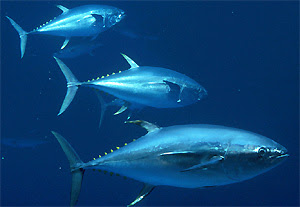



Tuna is known as one of the healthy food since it contains Omega 3 fatty acids, good source of protein, and high in potassium and vitamin B. With a wealth of nutrients such as one made tuna dish at home is the best reference for family health. To make the dish a delicious and healthy tuna, recipe selection is also very crucial.



tuna is a streamlined fish, stout in the middle and tapering to points at either end. Two closely spaced dorsal fins rise from its back. The first is depressible–it can be laid down, flush, in a groove along the fish's back. The second dorsal fin and corresponding anal fin are long and pointed, resembling a sickle. Seven to 10 yellow finlets run between these fins and the tail, which is lunate–curved like a crescent moon–and tapered to pointy tips. The caudal peduncle, to which the tail is attached, is very slender, with three stabilizing keels on each side. The tuna's dorsal side is generally a metallic dark blue color, while the ventral side, or underside, is silvery or whitish.
Tuna is a fish commercially important fisheries commodities. NGO International Seafood Sustainability Foundation has compiled a detailed report on the world's tuna stocks in 2009, which was revised on a regular basis. According to the report,
"The types of tuna are important for fisheries and sport fishing are yellowfin, big eye tuna, bluefin tuna and tuna-tatihu, albakor, and skipjack.



Between 1940 and mid-1960s, world fisheries catches of the five most important tuna species has been increasing from about 300 thousand to about a million tons per year, most of them with a fishing pole. With technological developments trawl gear rings (purse-seine), in recent years tuna catches jumped to more than 4 million tons per year. Approximately 68 percent of that figure comes from the Pacific Ocean, 22 percent of the Indian Ocean, and the remaining 10 percent divided between the Atlantic and the Mediterranean. Skipjack catch is dominated by up to 60% catch, followed by yellowfin (24%), large eyes (10%) and albakor (5%). Approximately 62% of world production caught with ring nets, by 14% by using longline tuna fishing (longline), 11% with huhate fishing (pole and line), the rest by means of others. "
there are various kind of tuna recipes. as you can see tuna is major food with high quality nitritions














In 2006 the Australian Government alleges that Japan has to harvest tuna in excess (overfishing) and illegal, by capturing 12-20 thousand tons per year, far above the agreed quota of 6 thousand tonnes per year.



The value of excess catch was estimated at 2 billion dollars (U.S.). Excess arrest was alleged to have been damaged bluefin tuna stock
No comments:
Post a Comment